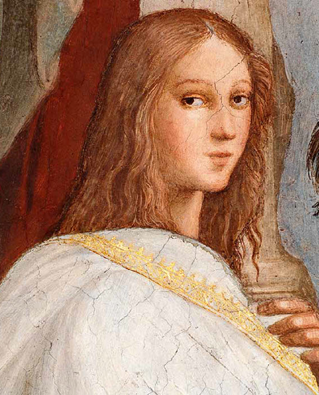Reseña
Philosopher, mathematician, and astronomer who taught at the Library of Alexandria alongside her father and other notable figures in the 4th century. She was one of the great scientists of antiquity.
Justificaciones
- [[en]]Hypatia is a female reference in the world of classical physics and mathematics, fields in which many thinkers are known for their contributions in transforming ideas into major theories and laws—concepts that she had already been able to describe many years earlier.
Biografía
She was a Greek Neoplatonic philosopher and teacher from Egypt who excelled in the fields of mathematics and astronomy. She was a member and leader of the Neoplatonic School of Alexandria at the beginning of the 5th century. A follower of Plotinus, she pursued studies in logic and the exact sciences, living an ascetic life. She educated a select group of aristocratic Christians and pagans who went on to hold high-ranking positions, including Bishop Synesius of Cyrene—who maintained significant correspondence with her—Hesychius of Alexandria, and Orestes, the prefect of Egypt at the time of her death.
Daughter and disciple of the astronomer Theon, Hypatia was one of the greatest female mathematicians of antiquity, following in the tradition of the Pythagorean Theano of Croton. She wrote about geometry, algebra, and astronomy, improved the design of early astrolabes—devices used to determine the positions of stars in the celestial sphere—and invented the hydrometer. For these achievements, she is considered one of the most prominent scientists of antiquity, alongside Maria of Alexandria, and a significant figure in the history of women in science.
Hypatia studied Diophantine equations and analysed conic sections, which were later used by Newton. She was also an important Neoplatonic philosopher. Her works have not survived, but they are known through indirect writings.
She revised the letters of the astronomer Claudius Ptolemy, known for their inclusion in Hesychius’ Astronomical Canon. Hypatia updated the Ptolemaic tables, which impacted Ptolemy's ideas, as she proposed that the Sothic year was more accurate than the tropical year. What stands out about this commentary on Ptolemy's Syntaxis Mathematica in the third book is that, initially, it was thought to be a simple correction of her father’s work. However, historian Cameron believes it is a new text written by Hypatia, suggesting that her works have not been completely lost (Dzielska, Maria, 2004).
Hypatia was murdered at the age of 45 or 60 (depending on the correct date of her birth), and lynched by a mob of Christians.
Obras
None of Hypatia's works have been preserved, although one text may be possibly attributed to her, and her contributions are known indirectly, including:
-A commentary on Arithmetic by Diophantus of Alexandria
-A commentary on the Conic Sections by Apollonius of Perga
-A revision of Claudius Ptolemy's astronomical tables
-An edition of Euclid's Elements
-It is also known that she invented a distiller, a device to measure water levels, and a graduated hydrometer to measure the relative density of liquids, a precursor to the modern aerometer (Vare, Ethlie Ann, and Ptacek, Greg, 1988, Mothers of Invention)
-She invented the densimeter
Bibliografía
Dzielska, María (2004 [5ª edición 2009]). Hipatia de Alejandría. Madrid: Siruela
Hypatia https://en.wikipedia.org/wiki/Hypatia
Kingsley, Charles (2009). Hipatia de Alejandría, Barcelona: Editorial Edhasa
Vare, Ethlie Ann and Ptacek, Greg (1988) Mothers of Invention
Enfoque Didáctico
In Physics and Chemistry, she can be mentioned when studying motion and forces. Also, when exploring universal gravitation and the motion of planets.
In Mathematics, she can be mentioned when working with equations.
In Technology, with the densimeter.
In Classical Culture, as an example of the brilliant cultural period enjoyed by the city of Alexandria in antiquity.
In Geography and History, when studying Greek and Roman antiquity.
In Philosophy, as a Neoplatonic philosopher.
Documentos
